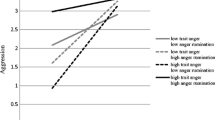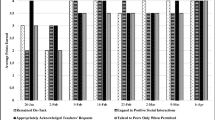Abstract
Although stimulant medication reduces hyperactive children's aggression in naturalistic settings, stimulant effects on anger control have not been demonstrated. We therefore assessed the role of methylphenidate in enhancing response to verbal provocation from familiar peers and from role-playing adults. Twenty-four boys with attention deficithyperactivity disorder (ADHD), aged 6–12, received small-group cognitivebehavioral intervention in anger management skills. During posttraining assessments, the children were randomly assigned to placebo versus. 6 mg/kg of methylphenidate. In the peer provocations, methylphenidate enhanced self-control, decreased physical retaliation, and marginally increased the display of coping strategies. Medication and prompting were minimally beneficial in the delayed, adult-administered generalization assessments. Among the issues discussed are (a) differences between peer and adult provocation and (b) the roles of medication dosage and multimodality intervention for promoting socially competent behavior in children with ADHD.
Similar content being viewed by others
References
Abikoff, H., & Gittleman, R. (1985). Hyperactive children treated with stimulants: Is cognitive training a useful adjunct?Archives of General Psychiatry, 42, 953–961.
Barkley, R. A., & Cunningham, C. E. (1978). Do stimulant drugs improve the academic performance of hyperkinetic children?Clinical Pediatrics, 17, 85–92.
Barkley, R. A., & Cunningham, C. E. (1979). The effects of methylphenidate on the motherchild interactions of hyperactive children.Archives of General Psychiatry, 36, 201–208.
Dodge, K. A., Pettit, G. S., McClaskey, C. L., & Brown, M. M. (1986). Social competence in children.Monographs of the Society for Research in Child Development, 51, (2, Serial No. 213).
Douglas, V. I., Barr, R. G., Amin, K., O'Neill, M. E., & Britton, B. G. (1988). Dosage effects and individual responsivity to methylphenidate in attention deficit disorder.Journal of Child Psychology and Psychiatry, 29, 453–475.
Douglas, V. I., Barr, R. G., O'Neill, M. E., & Britton, B. G. (1986). Short term effects of methylphenidate on the cognitive, learning, and academic performance of children with attention deficit disorder in the laboratory and the classroom.Journal of Child Psychology and Psychiatry, 27, 191–211.
Feindler, E. L., & Ecton, R. B. (1986).Adolescent anger control: Cognitive-behavioral techniques. Elmsford, NY: Pergamon Press.
Gadow, K. D. (1986).Children on medication (Vol. 1). San Diego: College-Hill Press.
Gittelman, R., Abikoff, H., Pollack, E., Klein, D. F., Katz, S., & Mattes, J. (1980). A controlled trial of behavior modification and methylphenidate in hyperactive children. In C. K. Whalen & B. Henker (Eds.),Hyperactive children: The social ecology of identification and treatment (pp. 221–243). New York: Academic Press.
Glow, R. A., & Glow, P. H. (1980). Peer and self-rating: Children's perception of behavior relevant to hyperkinetic impulse disorder.Journal of Abnormal Child Psychology, 8, 471–490.
Goldstein, A. P., & Keller, H. R. (1987).Aggressive behavior: Assessment and intervention. Oxford: Pergamon Press.
Goyette, C. H., Conners, C. K., & Ulrich, R. F. (1978). Normative data on revised Conners Parent and Teacher Rating Scales.Journal of Abnormal Child Psychology, 6, 221–236.
Herjanic, B. (1981).The Diagnostic Interview for Children and Adolescents: Parent version (DICA-P). St. Louis: Washington University.
Hinshaw, S. P. (1987). On the distinction between attentional deficits/hyperactivity and conduct problems/aggression in child psychopathology.Psychological Bulletin, 101, 443–463.
Hinshaw, S. P., Alkus, S. R., Whalen, C. K., & Henker, B. (1979).Training manual for STAR program. Unpublished manuscript, University of California, Los Angeles.
Hinshaw, S. P., Henker, B., & Whalen, C. K. (1981).Self-regulation for hyperactive boys: A training manual. Unpublished manuscript, University of California, Los Angeles.
Hinshaw, S. P., Henker, B., & Whalen, C. K. (1984). Self-control in hyperactive boys in angerinducing situations: Effects of cognitive-behavioral training and of methylphenidate.Journal of Abnormal Child Psychology, 12, 55–77.
Hinshaw, S. P., Henker, B., Whalen, C. K., Erhardt, D. D., & Dunnington, R. E., Jr. (in press). Aggression, prosocial, and nonsocial behavior in hyperactive boys: Dose effects of methylphenidate in naturalistic settings.Journal of Consulting and Clinical Psychology.
Hinshaw, S. P., & McHale, J. P. (in press). Stimulant medication and the social interactions of hyperactive children: Effects and implications. In D. G. Gilbert & J. J. Conley (Eds.),Personality, social skills, and psychopathology: An individual differences approach. New York: Plenum Press.
Huesmann, L. R., Eron, L. D., Lefkowitz, M. M., & Walder, L. O. (1984). Stability of aggression over time and generations.Developmental Psychology, 20, 1120–1134.
Loney, J. (1987). Hyperactivity and aggression in the diagnosis of attention deficit disorder. In B. B. Lahey & A. E. Kazdin (Eds.),Advances in clinical child psychology (Vol. 10, pp. 99–135). New York: Plenum Press.
Murphy, D. A., Pelham, W. E., & Lang, A. R. (1986, August).CNS stimulant effects on aggression in ADD and ADD/aggressive children. Paper presented at the meeting of the American Psychological Association, Washington, DC.
Novaco, R. W. (1979). The cognitive regulation of anger and stress. In P. C. Kendall & S. D. Hollon (Eds.),Cognitive-behavioral interventions: Theory, research, and procedures (pp. 241–285). New York: Academic Press.
Parker, J. G., & Asher, S. R. (1987). Peer relations and later personal adjustment: Are lowaccepted children at risk?Psychological Bulletin, 102, 357–389.
Pelham, W. E., & Bender, M. E. (1982). Peer relationships in hyperactive children: Description and treatment. In K. D. Gadow & I. Bialer (Eds.),Advances in learning and behavioral disabilities (Vol. 1, pp. 365–436). Greenwich, CT: JAI Press.
Pelham, W. E., & Hoza, J. (1987). Behavioral assessment of psychostimulant efects on ADD children in a summer day treatment program. In R. Prinz (Ed.),Advances in behavioral assessment of children and families (Vol. 3, pp. 3–34). Greenwich, CT: JAI Press.
Pelham, W. E., & Murphy, H. A. (1986). Attention deficit and conduct disorders. In M. Hersen (Ed.),Pharmacological and behavioral treatments: An integrative approach (pp. 108–148). New York: Wiley.
Pelham, W. E., & Murphy, D. A. (1988).Disruptive Behavior Disorders Checklist. Unpublished manuscript, University of Pittsburgh.
Swanson, J., Nolan, W., & Pelham, W. (1981, August).The SNAP rating scale for the diagnosis of the attention deficit disorder. Paper presented at the meeting of the American Psychological Association, Los Angeles.
Whalen, C. K., & Henker, B. (1985). The social worlds of hyperactive (ADDH) children.Clinical Psychology Review, 5, 447–478.
Whalen, C. K., Henker, B., Buhrmester, D., Hinshaw, S. P., Huber, A., & Laski, K. (1989). Does stimulant medication improve the peer status of hyperactive children?Journal of Consulting and Clinical Psychology, 57, 545–549.
Whalen, C. K., Henker, B., Castro, J., & Granger, D. (1987). Peer perceptions of hyperactivity and medication effects.Child Development, 58, 816–828.
Whalen, C. K., Henker, B., & Granger, D. A. (1989). Ratings of medication effects in hyperactive children: Viable or vulnerable?Behavioral Assessment, 11, 179–199.
Author information
Authors and Affiliations
Additional information
We gratefully acknowledge the Fernald Child Study Center of the University of California, Los Angeles, which provided major support for this research. In addition, we acknowledge the dedication of the small-group trainers, too numerous to mention individually, who led the intervention procedures for the children, and the experimenters who performed the individual provocation assessments. The careful behavior observations of Linda Douglas, Rebecca Eiser, Deborah Gibson, Mike Glenn, Melissa Michaelson, Jon Rafuse, Fauzia Simjee, Leslie Sherman, and Madelin Tundidor were central to the study. Finally, our colleagues Barbara Henker and Carol K. Whalen were instrumental in facilitating all aspects of this investigation.
Rights and permissions
About this article
Cite this article
Hinshaw, S.P., Buhrmester, D. & Heller, T. Anger control in response to verbal provocation: Effects of stimulant medication for boys with ADHD. J Abnorm Child Psychol 17, 393–407 (1989). https://doi.org/10.1007/BF00915034
Revised:
Issue Date:
DOI: https://doi.org/10.1007/BF00915034




